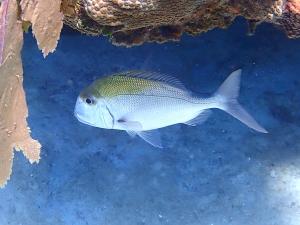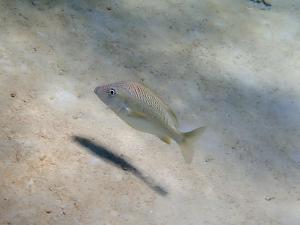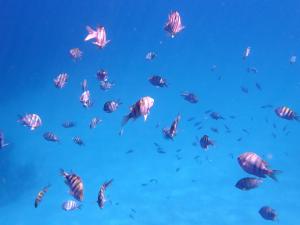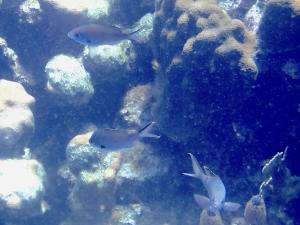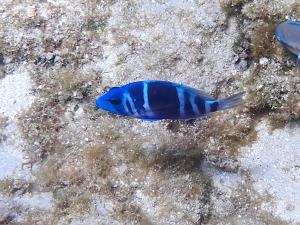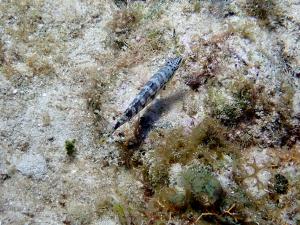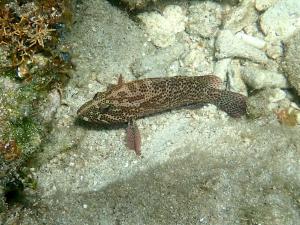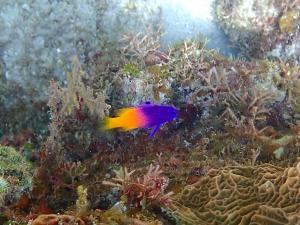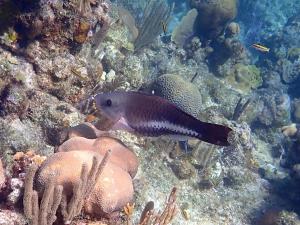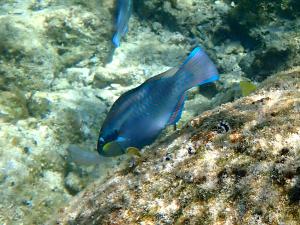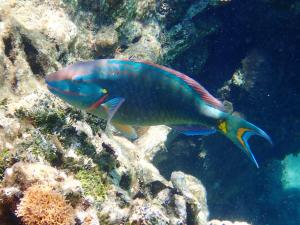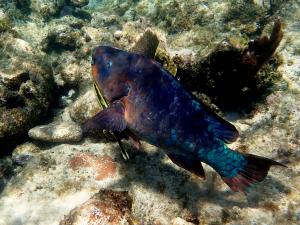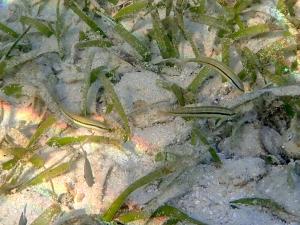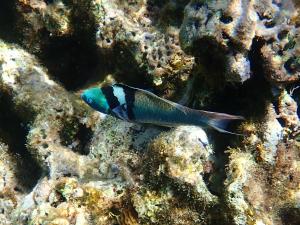
Grand Roatan, West Bay, Roatan
The Grand Roatan Resort and Spa, West Bay Road, Roatan, Honduras.
Coordinates in degrees decimal: N 16.271667, E -86.600000
Visited in February-March, 2019. Photographer: Nigel Thomas. Cameras: Pentax WG-II, Sea & Sea 1G with DX1G housing and Olympus Tough T5.
Roatan Island sits approximately 50 kilometres north of the coast of Honduras. West Bay is located at the western end of the island and is in a north to south orientation. A coral reef stretches over the length of the bay but is closest to shore in the southern part of the bay. The reef edge is between 100 and 200 metres from shore in the most accessible areas. Two resorts are located immediately adjacent this stretch of beach; The Grand Roatan (www.grandroatanresort.com) and The Infinity Bay Spa and Beach Resort (www.infinitybay.com). The Grand Roatan, in particular, has made strenuous efforts to protect the reef, through a variety of initiatives.
Tidal range is very limited, less than 0.3M, with wind conditions in the area ideal, as they blow from the east almost all year round. Marine life diversity is good with over 160 species recorded over a 10 day period, although some of the fish species were unusually skittish, which is my excuse for not catching a good image of the more common species! Sadly, some of the reef is showing signs of wear and tear, with several areas of moribund coral and examples of poor coral health, with patches of algal and sponge overgrowth. Visitor pressure is also having an effect, despite the efforts of the wardens who appear to be constantly telling people not to stand on the coral. So please don't stand on the coral!
Completed without the support of the resorts.
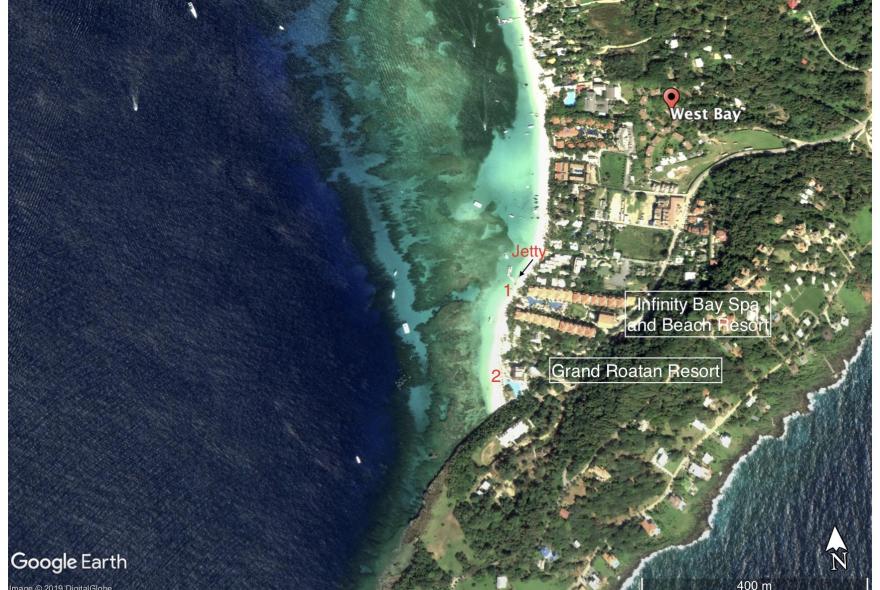
Snorkelling from shore is restricted to the southern part of the bay, with two easy access points. Entry point 1 is just to the left of the jetty (facing the sea), in front of the Infinity Bay Spa and Beach Resort; entry point 2 is directly in front of the Grand Roatan Resort, with several bouys in place to mark the safest route. All areas to the north of the jetty are subject to intense vessel activity all day, and it would be unsafe to venture into this area, unless in marked swimming areas.
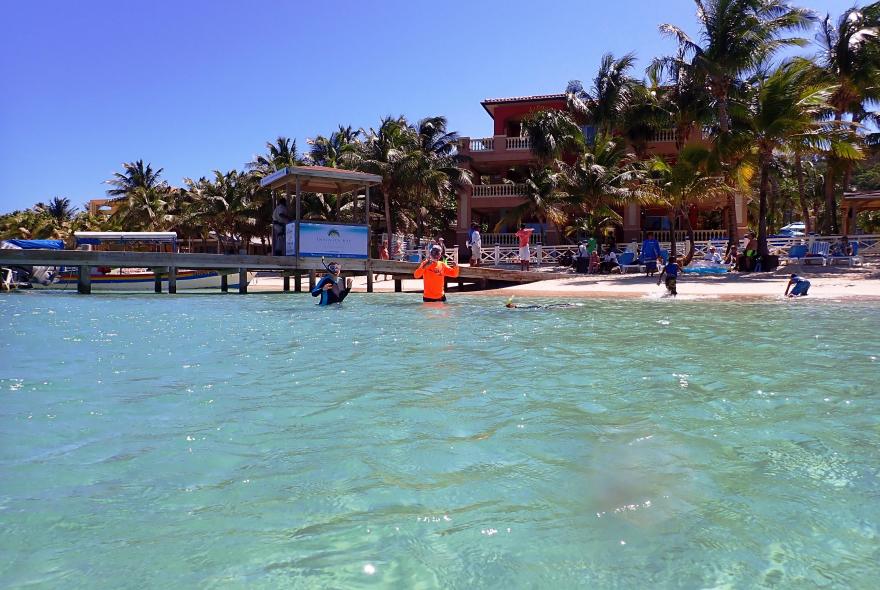
Entry point 1, next to the jetty in front of the Infinity Bay Spa and Beach Resort. Note that this area may get crowded while cruise vessels are visiting, which generally occurs around 10:00. In the shallow waters the seabed is composed of flat sands, with plenty of fast swimming fish.
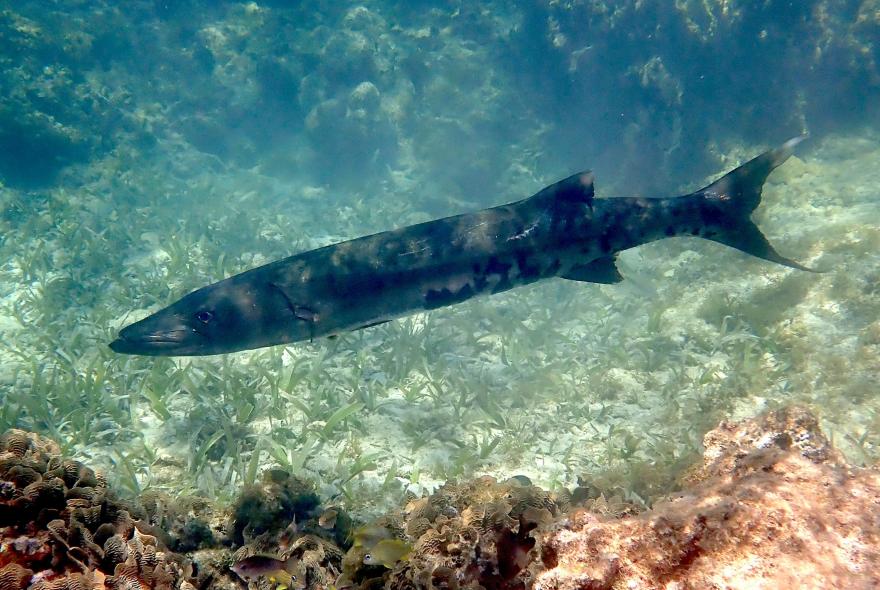
Further offshore the sands are replaced by mixed seagrasses, cobbles and small boulders. The sands persist as corridors through the reef in several places. These inshore habitats support a characteristic group of species as well as some of the more offshore species, such as this Giant Baracuda.
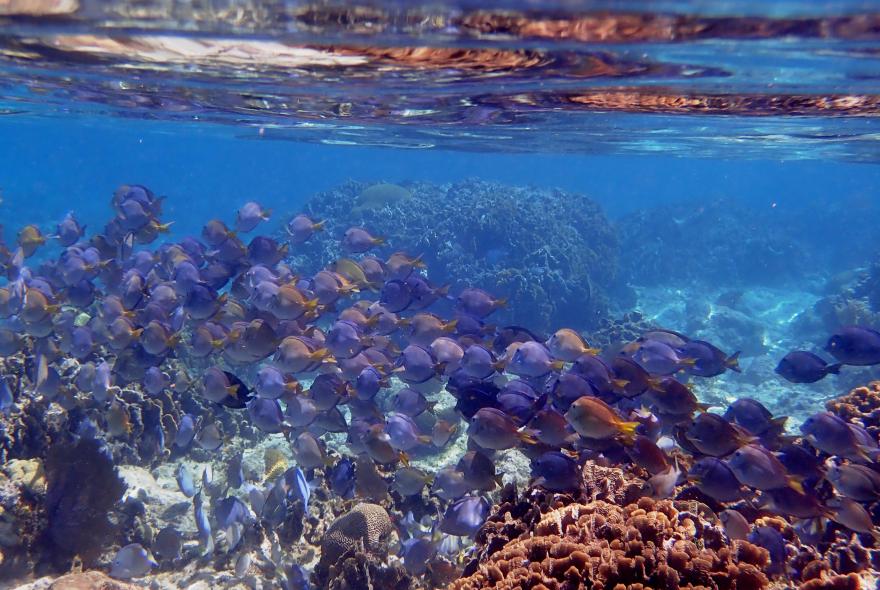
The reef areas, particularly to the south of the bay, are very shallow and care has to be taken if you try to swim through or across them. Despite this you will be rewarded with areas teeming with life, including numerous shoals of fish, such as this group of Doctorfish, Surgeonfish and Blue Tang.
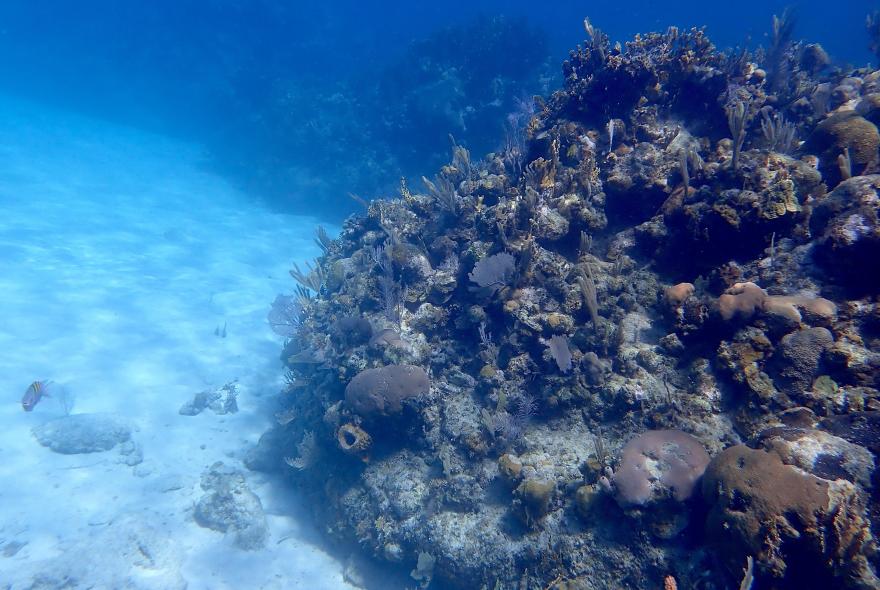
The outer edge of the reef has various profiles from vertical to steeply sloping. The area is populated by numerous coral, seafan and sponge species. Past the reef edge flat sands are present. The outer edge of this reef is where the glass bottom boat cruises. A secondary reef also exists, slightly further out, which is frequently visited by diving groups, who secure their vessels to fixed bouys.
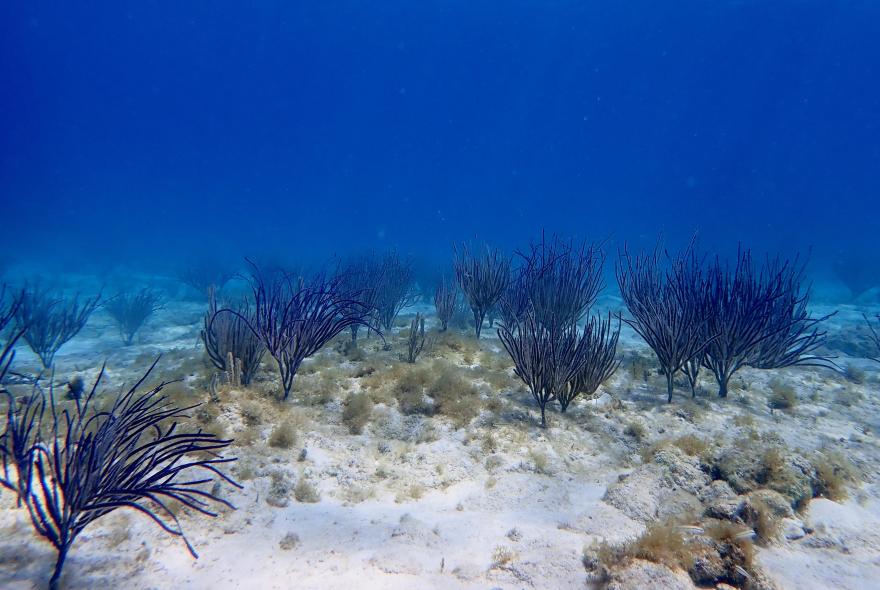
Although the area between the first reef edge and the secondary reef is largely sand, other habitats exist, including this unusual field of Seawhips.
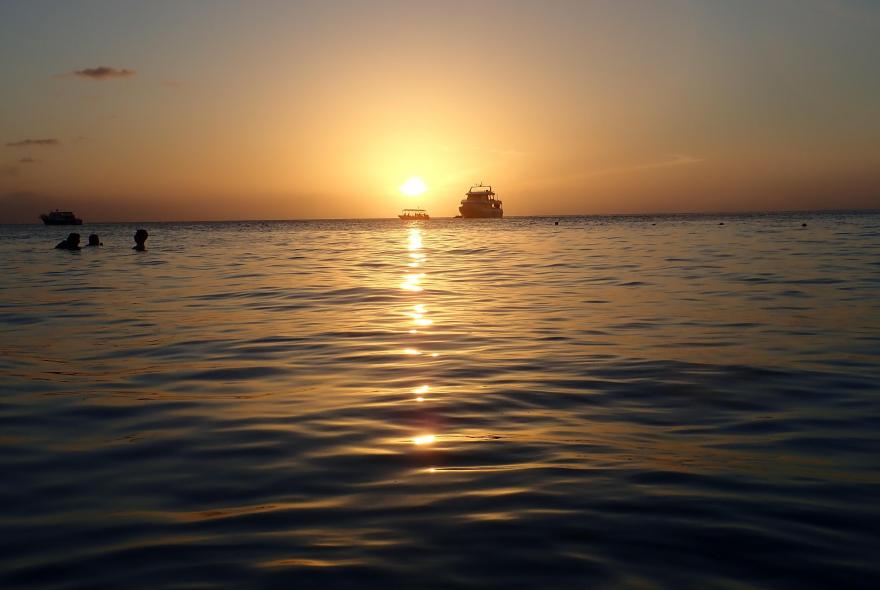
If you fancy a night snorkel the recommended approach is to commence just as the sun is setting and swim towards the sun, starting from the jetty outside the Infinity Bay Resort. This will take you into a sand gully that runs between vertical reef walls, initially marked with bottom ropes.
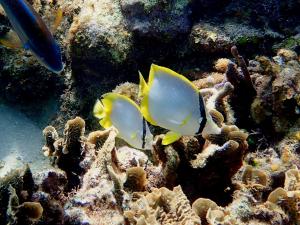
Spotfin Butterflyfish. Chaetodontidae. Chaetodon ocellatus. Frequently found in pairs over the top of the reef.
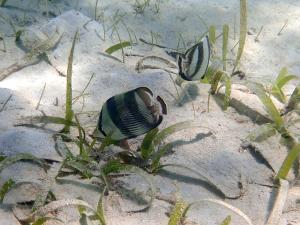
Banded Butterflyfish. Chaetodontidae. Chaetodon striatus. Generally found over the top of the reef, although equally happy over seagrass/sand. Often in pairs.
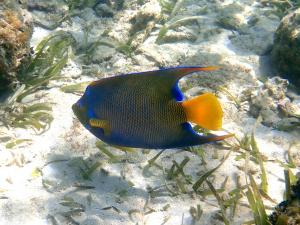
Queen Angelfish. Pomacanthidae. Holacanthus ciliaris. Throughout the area including over reef, seagrass and cobbles.
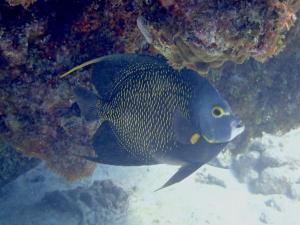
French Angelfish. Pomacanthidae. Pomacanthus paru. Infrequently found over reef, generally in sheltered areas with overhangs.
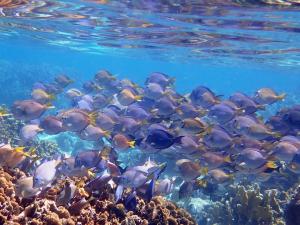
Shoal of Blue Tang. Acanthuridae. Acanthurus coeruleus. Commonly seen in large shoals over the top of the reef. Often mix with Ocean Surgeonfish and Doctorfish.
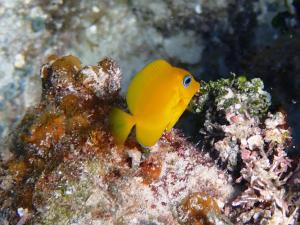
Juvenile Blue Tang. Acanthuridae. Acanthurus coeruleus . Despite the name the juvenile of the Blue Tang is almost entirely yellow.
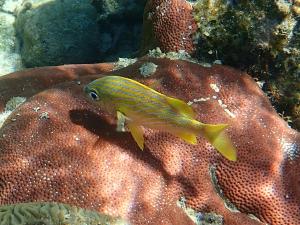
French Grunt. Haemulidae. Haemulon flavolineatum. Normally found in small groups in shaded areas of the reef.
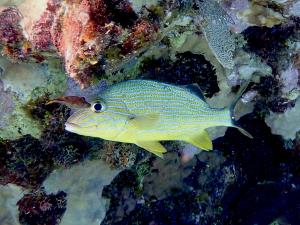
Bluestriped Grunt. Haemulidae. Haemulon sciurus. Being looked in the eye by a Sharpnose Puffer. Tetraodontidae. Canthigaster rostrata. Noted under overhangs.
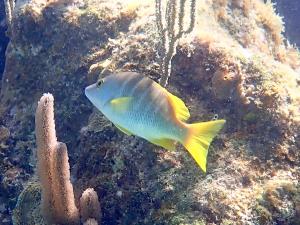
Immature Schoolmaster. Lutjanidae. Lutjanus apodus. Distinctive yellow fins in combination with bars across the back. Noted in shaded areas with overhangs on reef.
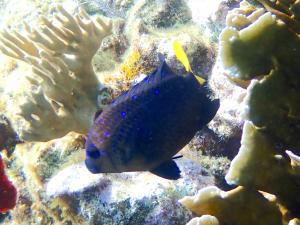
Yellowtail Damselfish. Pomacentridae. Microspathodon chrysurus. Fluorescent blue dots and yellow tail characterise this species. Noted over the top of the reef where they maintain a small territory.
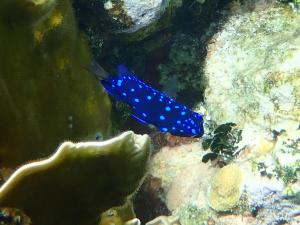
Juvenile Yellowtail Damselfish. Pomacentridae. Microspathodon chrysurus. Fluorescent blue dots are more distinct in the juvenile phase.
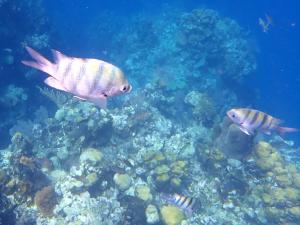
Sergeant Major. Pomacentridae. Abudefduf saxatilis. One of the most common species in the area. Generally collects in shoals, often quite large, over the top of the reef.
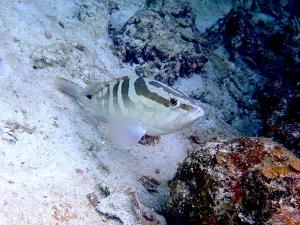
Nassau Grouper. Serranidae. Epinephelus striatus. Noted in a large canyon, with a sandy floor, to the south of the bay.
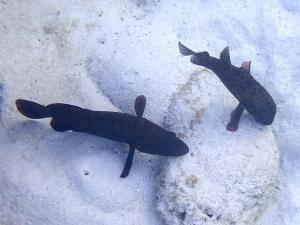
Probably Rock Hind. Serranidae. Epinephelus ?adscensionis. Very dark colouration so doubt over identification. Noted in very shallow waters on boulder outcrops.
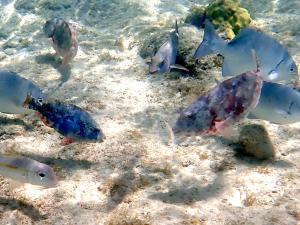
Two red speckled individuals, left and right of centre. Initial Phase Redtail Parrotfish. Scaridae. Sparisoma chryopterum. Noted feeding over peripheral rocky habitats in the company of several other species.
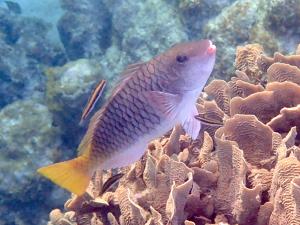
Initial Phase Yellowtail Parrotfish. Scaridae. Sparisoma rubripinne. Noted over reef top, receiving attention from a cleaner fish.
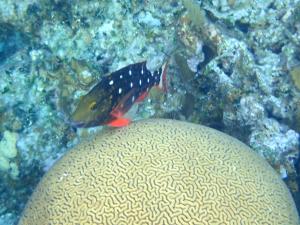
Bit fuzzy but distinctive white spots identify this as a juvenile Stoplight Parrotfish. Scaridae. Sparisoma viride.
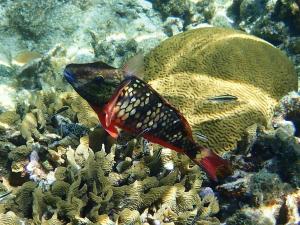
Initial Phase Stoplight Parrotfish. Scaridae. Sparisoma viride. Found over the top of the reef, in this case in the company of numerous juvenile Bluehead Wrasse.
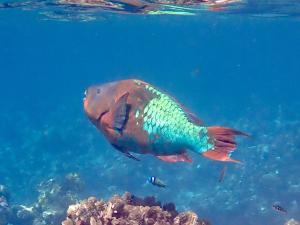
Rainbow Parrotfish. Scaridae. Scarus guacamaia. One of the largest of the parrotfish. Noted over the top of the reef.
Resort Downloads
See below for related resorts downloads
